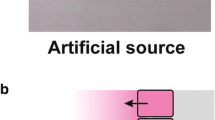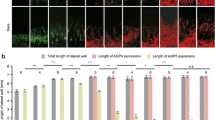Summary
In order to examine the intracellular potential of stria vascularis marginal cells (MCs) under direct visual control, a short-term organ culture of guinea pig stria vascularis (SV) was developed. The experimental conditions allowed exposure of the luminal surface of the SV to artificial endolymph or perilymph. Using conventional microelectrodes and inverted bright-field microscopy, impalement of MCs from the endolymphatic side through the luminal cell membrane was achieved. With artificial perilymph at the luminal side a small positivity at the cell surface and low negative intracellular potentials were recorded at room temperature (23°C). The initial recording was −6.5 ± 5.0 mV while the stable recording was −4.0 ± 3.6 mV. Similar results were obtained at a bath temperature of 37°C. Furthermore, subtotal exposure of the luminal cell surface to artificial endolymph did not result in a significant potential change.
Similar content being viewed by others
References
Chou JTY, Hellenbrecht D (1979) Further studies of the membrane potential of the stria cells of the guinea pig in vitro. Acta Otolaryngol (Stockh) 88:187–197
Chou JTY, Okumura H, Vosteen KH (1975) Resting membrane potential of the stria cells of the guinea pig. Experimenta 31:554–556
Dallos P, Cheatham MA, Offner FF (1987) Positive endocochlear potential. New ideas and new experiments. Abstr Assoc Res Otolaryngol 10:239–240
Gummer M (1983) DC potentials of the stria vascularis of the guinea pig cochlea. Honest thesis, Department of Physiology, University of Western Australia
Johnstone BM (1967) Genesis of the cochlear endolymphatic potential. In: Sanadi DR (ed) Current topics in bioenergetics. Academic Press, New York, pp 335–352
Konishi T, Harick PE, Walsh PJ (1978) Ion transport in guinea pig cochlea. I. Potassium and sodium transport. Acta Otolaryngol (Stockh) 86:22–34
Marcus DC (1986) Nonsensory electrophysiology of the cochlea: stria vascularis. In: Altschuler RA, Hoffmann DW, Bobbin RP (eds) Neurobiology of hearing: the cochlea. Raven Press, New York, pp 123–137
Marcus DC, Marcus NY, Thalmann R (1981) Changes in cation contents of stria vascularis with ouabain and potassium free perfusion. Hear Res 4:149–160
Melichar I, Syka J (1987) DC potentials in different cells of the stria vascularis measured in vitro. Hear Res 25:23–33
Melichar I, Syka J (1987) Electrophysiological measurements of the stria vascularis potentials in vivo. Hear Res 25:35–43
Morgenstern C, Amano H, Orsulakova A (1982) Ion transport in the endolymphatic space. Am J Otolaryngol 3:323–327
Offner FF, Dallos P, Cheatham MA (1987) Positive endocochlear potential: mechanism of production by marginal cells of stria vascularis. Hear Res 29:117–124
Prazma J (1975) Electroanatomy of the lateral wall of the cochlea. Arch Otorhinolaryngol 209:1–13
Author information
Authors and Affiliations
Rights and permissions
About this article
Cite this article
Gitter, A.H., Ikeda, M. & Zenner, H.P. The resting potential of marginal cells in stria vascularis explants. Eur Arch Otorhinolaryngol 248, 492–494 (1991). https://doi.org/10.1007/BF00627641
Accepted:
Issue Date:
DOI: https://doi.org/10.1007/BF00627641




